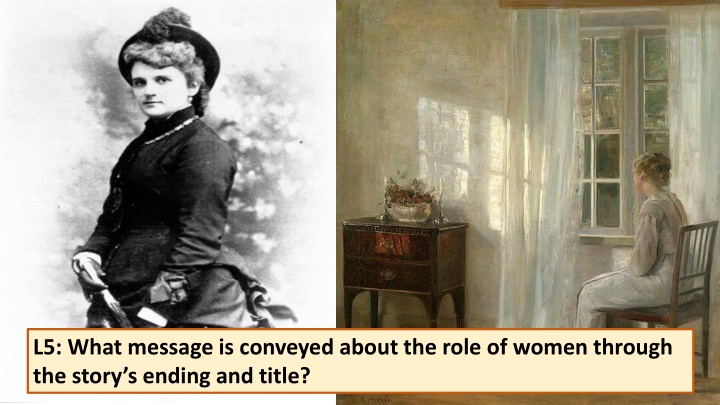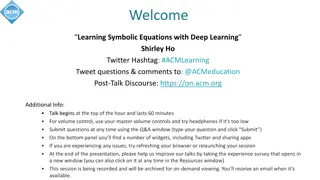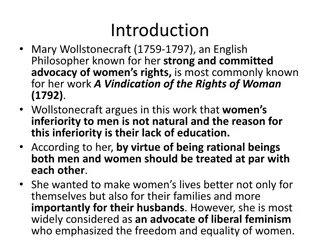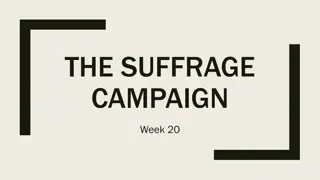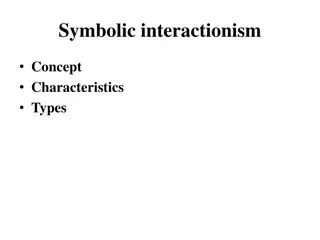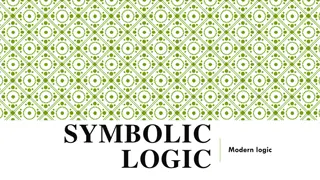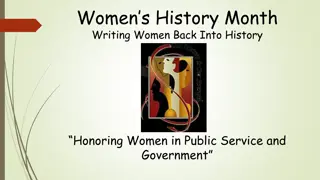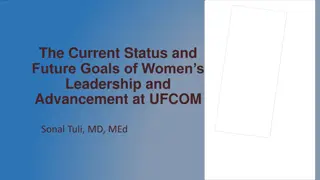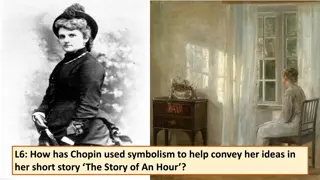The Role of Women in "The Story of an Hour": A Symbolic Ending
The ending of "The Story of an Hour" conveys a message about the role of women through unexpected revelations. The return of Brently Mallard, not dead as thought, symbolizes control and the loss of freedom. The grip-sack and umbrella he carries metaphorically represent his tight hold over Louise's life. The story hints at the dangers of rapid technological advancements and societal expectations on women's roles.
Download Presentation

Please find below an Image/Link to download the presentation.
The content on the website is provided AS IS for your information and personal use only. It may not be sold, licensed, or shared on other websites without obtaining consent from the author.If you encounter any issues during the download, it is possible that the publisher has removed the file from their server.
You are allowed to download the files provided on this website for personal or commercial use, subject to the condition that they are used lawfully. All files are the property of their respective owners.
The content on the website is provided AS IS for your information and personal use only. It may not be sold, licensed, or shared on other websites without obtaining consent from the author.
E N D
Presentation Transcript
L5: What message is conveyed about the role of women through the story s ending and title?
Recap questions Recap questions 1. What is situational irony and what role does it play in The Story of an Hour ? 2. What is Louise Mallard s epiphany? 3. How do Louise Mallard s emotions develop as she begins to appreciate her new reality? 4. What is the difference between selfhood and self-assertion? Do it now
The Ending of The Story of an Hour She clasped her sister s waist, and together they descended the stairs. Richard stood waiting for them at the bottom. Some one was opening the front door with a latchkey. It was Brently Mallard who entered, a little travel-stained, composedly carrying his grip-sack and umbrella. He has been far from the scene of the accident, and did not even know there had been one. He stood amazed at Josephine s piercing cry; at Richards quick motion to screen him from the view of his wife. When the doctors came they said she had died of heart disease of the joy that kills. New knowledge
The Ending of The Story of an Hour New knowledge 1. The return of Brently Mallard 2. The grip-sack and the umbrella 3. they said she had died of heart disease of the joy that kills.
The return of Bradley Mallard The return of Bradley Mallard It was Brently Mallard who entered, a little travel-stained, New knowledge The adjectives travel-stained to describe Mallard present a commuter and pay reference to the technological advancement which would see husbands spend more time away. The husband returning reveals it wasn t her husband who died in the crash. Again, a potential reference to technological advancement and the increase in the speed of communication via telegram and the potential pitfall / dangers of this. Alongside, a wider warning about the overall increase in the speed of life? Reference: title The Story of an Hour
The importance of symbolism The importance of symbolism It was Brently Mallard who entered, a little travel- stained, composedly carrying his grip-sack and umbrella. Literally A small suitcase or travelling bag Metaphorically Grip means to hold tightly Sack a large bag or a woman s loose fitting straight dress Sack to plunder / steal and to lay to waste Compound word grip-sack symbolically suggests that Brent Mallard not only firmly grips Louise s life but also tightly controls Louise s fate by plundering and laying to waste her freedom and self-identity. New knowledge
The importance of symbolism The importance of symbolism It was Brently Mallard who entered, a little travel-stained, composedly carrying his grip-sack and umbrella. Literally a device consisting of a circular canopy of cloth on a folding metal frame supported by a central rod, used as protection against rain. New knowledge Metaphorically Umbrella a sign of protection and this case the protection of marriage a husband to his wife and a man to his woman. Barbara C. Ewell In the United States as in most nations and cultures, patriarchal custom explicitly defined women as self-less. They were named and described only in terms of their relationship to men daughter, wife, mother, sister, widow or more specifically, in terms of their sexual relationships to men: virgin, whore, mistress, spinster. Women were as, Simone de Beauvoir so eloquently explained simply men s other defined as whatever men were not: not rational, not strong, not self. Women were not subjects, but objects of sexuality, of discourse, of art of men. The fact he is carrying an umbrella restores the sanctity of marriage and re-establishes the patriarchal structure in place.
The death of Louise Mallard The death of Louise Mallard Eliza O Flaherty Kate Chopin Louise Mallard When Thomas O Flaherty died, Kate who was at boarding school, was brought home to be raised by the powerful women in her family. Her father s death kept Kate from growing up in a typical nineteenth century patriarchal household in which a powerful husband ruled the roost. Kate would ponder her father s sudden death and what it meant for her mother. At Thomas O Flaherty s funeral the priest praised him for leaving his family the priceless heritage of an unsullied name. However, he left behind no will and no provision for his wife, his children, his other relatives and the slaves. Louise Mallard is told her husband has died after a railroad accident. She imagines life without him. He, however, returns alive and well. Louise Mallard dies from the shock. New knowledge Kate met her husband, Oscar Chopin during the Civil War and remarked I am going to be married, married to the right man. It does not seem strange as I had thought it would I feel perfectly calm, perfectly collected. They were married in 1870. Why is this narrative so different from the life of Eliza and Kate? Eliza O Flaherty s story would have been too radical, far too threatening, in the 1890s. Therefore, in order to make her story publishable, Kate Chopin had to disguise reality. She had to have her heroine die. It took nine days for Eliza to get herself and her children named, through an affidavit, as Thomas s official heirs. The couple settled in New Orleans where Oscar established a business as a cotton factor. The city of Louisiana was, however, beset with economic and racial troubles. At 27, she was a wealthy widow, in charge of a very large estate (valued at 24,610 in 1861). Widows controlled their property, as wives did not. Between 1871 and 1879 Kate gave birth to five sons and a daughter in order of birth, Jean Baptiste, Oscar Charles, George Francis, Frederick, Felix Andrew, and L lia (baptized Marie La za). In having Louise die, Chopin is suggesting that any woman seeking for ideal feminine selfhood is na ve and idealistic in a hostile patriarchal society that doesn t allow for any feminine self- assertion. In 1882, Oscar Chopin died of malaria, leaving Kate a widow at 32 with the responsibility of raising six children. Eliza s daughter, Kate, had been sent to a boarding school by her father so when Thomas died, Eliza removed her from the boarding school and decided to raise her amongst the powerful women of her family. Oscar left Kate in debt by about $42,000. Kate took over the running of his general store and plantation for over a year desperate to make it work. However, in 1884 she sold up and moved back to St. Louis to live with her mother who financially supported her. But Louise s search for selfhood and feminine emancipation with a prophetic vision and foresight suggests that Chopin is hopeful for the era to come. Chopin struggled with depression after the successive loss of her husband, her business, and her mother. Chopin's obstetrician and family friend, Dr. Frederick Kolbenheyer, suggested that she start writing, believing that it could be therapeutic for her. He understood also that writing could be a focus for her extraordinary energy, as well as a source of income.
The death of Louise Mallard The death of Louise Mallard Dramatic irony: when the readers of a text know more than the characters involved. New knowledge When the doctors came they said she had died of heart disease of the joy that kills. 1.We believe Louise Mallard to have a heart condition. 2.The shock (and joy) of seeing her husband alive killed her. Dramatic irony: the shock (and disappointment) of her husband s return has killed her.
The Story of an Hour was originally published using the title The Dream of an Hour in Vogue in 1894. By the time, the story appeared in St Louis Life in 1895, it had been re-titled The Story of an Hour . Reflection Based upon your learning from this lesson (and other lessons), why is the title The Story of an Hour relevant and appropriate? The Dream of an Hour relevant and appropriate? Which do you prefer and why?
